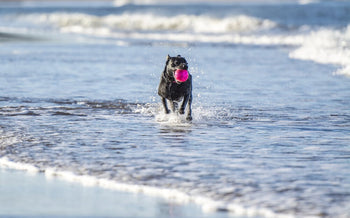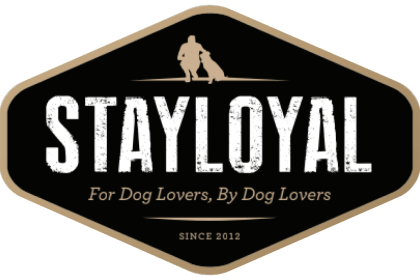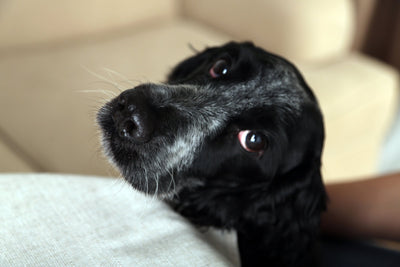How To Teach Your Dog to Fetch!

Fetch is a great way to exercise your dog if they have more stamina than you, which is often the case. It’s also a good to teach your dog to bring things back to you, because sometimes they end up with something you don’t want them to have – for example your shoe or something they find along a walk. Better that they bring it to you than think a game of chase is fun! However, not all dogs naturally fetch. Even a retriever breed may not be naturally inclined to bring something to you. That’s where training comes in. It is possible to teach dogs, even dogs with no interest in toys, how to fetch. It just may take longer than the ball-crazed Border Collie or die-hard Retriever.
BEFORE YOU START – Does your dog have play drive?
Toy or play drive is similar to prey drive. Many dogs enjoy toys because they can treat them like prey – chase, tug, rip, shred, shake and many of them even “squeal” (squeak) like prey. But not all dogs do. If your dog is not big on toys, you need to work on this before teaching a fetch. Here are some tips to help the dog that is not very enthusiastic about toys.
First, try lots of different types of toys in case the problem is just the type of toy and not toys in general. Here is a list of common “types” of toys to try:
· Soft or hard toys
· Toys that squeak or don’t squeak (sound sensitive dogs)
· Stuffed or not stuffed
· Round or long (a ball versus a stick)
· Crinkly ones (like the kind that sound like they have paper or a bottle in them)
· Food stuffed toys
You can help your dog find toys more interesting by:
1. Be exciting! If you seem excited about the toy it will help your dog be more excited about it.
2. Rewarding them for interaction with the toy – this works with dogs that are more food or attention motivated than toy driven. You can praise/reward them for looking at the toy, nosing it, pawing it, picking it up, etc.
3. Keep the toy moving. For some dogs, especially terriers and herding breeds, it’s the movement that excites them. See if that is the case for your dog. You can even tie a toy to a lunge whip or rope to make dragging easier. Make sure you allow them to catch the toy at some point – you don’t want to build frustration in your dog. (As a side note, if you worry about building too much chase drive – don’t use this method. You can also put it on cue, such as “get it” so it’s under a stimulus control.)
Teaching Fetch – BACKCHAINING
The easiest way to teach fetch is using a technique called backchaining. This is where you start by teaching your dog the last part of the behavior and work backwards to the beginning. In the case of fetch, then, we will start by teaching the dog to place a toy in your hand (or drop it at your feet if you prefer) and then back up to retrieving a toy you have tossed.
STEPS TO TEACHING FETCH
STEP 1: Get Them To Pick Up Toy
Bring out a toy and place it very close to your dog. DO NOT THROW IT YET! Anytime your dog interacts with it at all, praise/reward. (Note: a clicker can make this process go much quicker as you can be more accurate with your timing on marking the behavior you are looking for).
***Using the same toy can help the learning processes go quicker in the beginning as well, since dogs do not generalize learning. However, you then may have to repeat some of these steps with other toys. It’s up to you whether you want to switch it up in the beginning or later on.***
Once your dog has interacted with the toy, “reset” by removing the toy (placing behind your back for example) and then bringing it back out after a few seconds.
Build up your dogs interaction by delaying your praise/reward as your dog interacts more and more with the toy. YOU ARE LOOKING FOR YOUR DOG TO PUT THE TOY IN ITS MOUTH. Depending on how big of a toy dog he is, this may happen immediately, or it may take several sessions.
When your dog does pick up that toy – big party! Be excited and give him lots of praise to reinforce the behavior.
STEP 2: Add End Behavior
Now that your dog is picking up the toy each time you set it out, it’s time to add in your end behavior. For example, putting the toy in your hand.TO DO THIS….
Bring out a toy and place it very close to your dog. DO NOT THROW IT YET! As soon as your dog picks up the toy, place your hand close underneath it, but don’t grab it. Most dogs will place the toy in your hand naturally, some may even let go. If so, big jackpot (several treats) or lots of praise.
If your dog puts the toy in your hand, but doesn’t drop it, hold a treat by their nose with your other hand and when they release the toy to take the treat, praise them and give them the treat.
When your dog is dropping the toy as soon as your hand is placed underneath it’s time to move on!
Next time your dog picks up his toy, put your hand near it, but not underneath it. Will your dog move to put the toy in your hand??? IF SO THEN YOUR DOG UNDERSTANDS THE CONCEPT and is ready for the next step. If not, it’s okay, go back to reinforcing dropping the toy into your hand underneath a couple more times and try again. Maybe put your hand partway under the toy to make it easier.
Rule of thumb in dog training: If he fails, go back a step and make it easier for him by repeating the last behavior he was rewarded for or breaking up the steps even more.
When your hand is several inches from your dog and he moves to put the toy in it, it’s time to add the cue
Add your fetch word – fetch, bring it, toy, etc., – really you can use any word you want! To add the cue, say the word as your dog is placing the toy in your hand. This teaches him that your fetch word means “bring me the toy and put in my hand.”
Gradually increase the distance of how far your dog has to go to put the toy in your hand.
STEP 3: Add the Retrieve
Up to this point, you have just been placing the toy near your dog. Now it’s time to add the retrieve. Start by tossing the toy just a couple inches from your dog – something very easy – and say your fetch cue. Does he immediately go get it and put it in your hand? If so – big party! You can start to gradually increase the distance depending on your dog’s excitement for the game. For some dogs this may take longer, that’s okay!
Remember, if your dog fails three times, it just means he doesn’t understand the concept yet and you need to go back. Punishing him won’t help him get it faster, but it might make him not like toys. So don’t punish. Instead, go back to either placing the toy in your hand, or try tossing it closer to him. Tossing it more toward your dog can help too.
Following these steps and your dog will be retrieving sooner than you think! The important thing to remember is to train at your dog’s pace and have fun. This is supposed to be a game! Keep training session short at first (just five minutes is good!) and if your dog seems stuck (not getting it), stop and think about how you can change what you’re doing to help your dog get the concept. Like humans, each dog learns at a different pace and may even understand some methods better than others, so the best way to be successful is to be flexible in your training.








